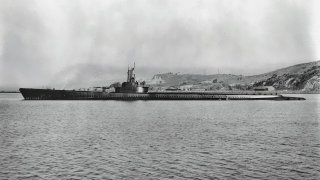USS Tang: The World War II Navy Submarine That Somehow Sank Itself
The USS Tang – named for a fish species and not for the powdered orange juice drink popularized by the Gemini astronauts – was a Balao-class submarine. She did not survive World War II
During the Second World War, the U.S. Navy referred to its submarines and their crews as "The Silent Service." Fittingly, the late great historian Clay Blair Jr. – himself a WWII submariner – chose Silent Victory as the title of his bestselling book on WWII USN subs. "The Silent Service" definitely made outstanding contributions to ultimate victory in the Pacific Theatre of operations, ravaging Imperial Japanese Navy (IJN) warships and Japanese merchant marine vessels alike.
However, American submariners paid a terrible price in exchange for the victory, to the tune of 52 submarines sunk and a combined 3,506 commissioned officers and enlisted sailors KIA – a death rate of 21.9% of total USN submarine manpower in WWII. Chances of surviving a submarine sinking were poor, and if the sinking took place whilst the boats were submerged, those survival chances were almost nil. One noteworthy exception was the eight survivors of the USS Tang, thanks to a remarkable invention called the Momsen Lung.
Meet "Swede" Momsen
The Momsen Lung was named for its inventor, Charles “Swede” Bowers Momsen, U.S. Naval Academy Class of 1919. "Necessity is the mother of invention," as the saying goes, and it was a series of tragic interwar submarine mishaps that motivated "Swede" to invent his namesake device in 1929. Among these tragedies were the S-4 disaster of December 1927 and the S-51 in 1925. For a detailed accounting of these submarine disasters as well as some other submarine losses that had happier ending for the crews, I recommend the book Hell at 50 Fathoms by Vice Admiral Charles Lockwood, Commander of the Submarine Force, U.S. Pacific Fleet (COMSUBPAC) during WWII.
The device itself was a relatively crude and primitive rebreather. As noted by USNA Museum Curator Dr. Scott Harmon, "It's just basically an airbag that you could breathe into and help you escape that later on more elaborate devices would be made." It worked by recycling breathing gas via the use of a counterlung containing soda lime to remove the CO2. The Lung was initially filled with oxygen and connected to a mouthpiece by twin hoses containing one-way valves, one for inhaling and the other for exhaling.
Crude or not, the Momsen Lung was good enough to earn then-Commander Momsen the Distinguished Service Medal in 1929. The Lung ended up only being used in real emergencies on two occasions, the first with the USS Squalus in 1939, followed by the only wartime usage in 1944 … which brings us to the story of the aforementioned USS Tang and its skipper, Medal of Honor recipient Richard Hetherington O'Kane.
Meet O'Kane and the USS Tang
The USS Tang – named for a fish species and not for the powdered orange juice drink popularized by the Gemini astronauts – was a Balao-class submarine. Under O'Kane's fearless leadership, the sub sank 33 ships totaling 116,454 tons, immortalizing its skipper as the most successful submarine commander of WWII.
Ironically, during the Tang's fateful fifth and final war patrol, it was not an IJN destroyer's depth charges, but rather one of the sub's own torpedoes, that compelled then-Commander O'Kane and his surviving crewmen to put Swede Momsen's invention to the ultimate test.
On October 25, 1944, after firing a total of 25 "tin fish" that resulted in the sinking of the freighters Kogen Maru and Matsumoto Maru, the very last "torp" malfunctioned, making a circular run and slamming into the submarine. O'Kane's boat sank by the stern to a depth of 180 feet (54.8 meters). Among the crew, 78 of the American sailors lost their lives, among them Cook 2nd Class Rubin MacNiel Raiford, who at the tender age of 15 was the youngest USN submariner to perish in combat. But O'Kane and seven of his men managed to don their Momsen Lungs and exit via the escape trunk in the forward torpedo room. These eight men were picked up the next morning by a Japanese frigate.
In yet another ironic twist of fate, that IJN frigate was also carrying survivors of Tang's previous sinking. These enraged surviving Japanese merchant mariners started exacting their revenge on the submariners. Later, O'Kane would quip about the ordeal, "When we realized that our clubbing and kickings were being administered by the burned, mutilated survivors of our handiwork, we found we could take it with less prejudice." O'Kane and his surviving crewmen were held as special prisoners at Ofuna prison camp near Yokosuka for the duration of the war.
O'Kane retired from the Navy as a Rear Admiral in 1957 and passed away at the age of 83 due to Alzheimer's disease on February 16, 1994. Swede Momsen retired from the Navy as a Vice Admiral in 1955 and passed away from cancer at age 70 on May 25, 1967.
About the Author
Christian D. Orr is a former Air Force officer, Federal law enforcement officer, and private military contractor (with assignments worked in Iraq, the United Arab Emirates, Kosovo, Japan, Germany, and the Pentagon). Chris holds a B.A. in International Relations from the University of Southern California (USC) and an M.A. in Intelligence Studies (concentration in Terrorism Studies) from American Military University (AMU). He has also been published in The Daily Torch and The Journal of Intelligence and Cyber Security. Last but not least, he is a Companion of the Order of the Naval Order of the United States (NOUS).
Image Credit: Creative Commons.


